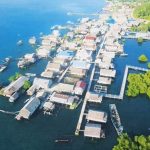A total of 157 Bajo’s families who lived the Bay of Hondolu Maranaung in Wasuamba Village, Lasalimu District, Buton Regency, Southeast Sulawesi (Southeast Sulawesi), were restless because according to local leaders, the government has designated their settlement area as a mangrove conservation area.
As many as eight Bajo figures, in Monday (February 25th, 2019) have been in Kendari, the capital city of Southeast Sulawesi Province to seek justice for their piece of Land. They came to appeal the Governor of Southeast Sulawesi, Ali Mazi, and the Southeast Sulawesi Regional House of Representative to release 63 ha of Bajo residential land from the status of forest area into a settlement. The request was not without reason. According to local religious leader, Ser Ali (71), the Bajo tribe inhabited Wasuamba since the 1930s, before Indonesian independence. Meanwhile, the forest area status was set later in 1994. That mean, after 64 years Bajo’s tribe lived for generation on the land consisting of the ocean and a little mainland, they then disturbed by the status of forest areas in their settlement.
Initially, the Bajo tribe lived scattered on the east coast of Buton Island but by Sultan Buton 1930 to 1969, La Ode Falihi ordered to live together in one permanent place. The story at that time was Ser Ali’s Father, La Worose, ordered by Sultan La Ode Falihi (father of La Ode Manarfah) to unite the Bajo people who lived scattered on the coast of the eastern Island of Buton Island to be inhabited.
Regarding the request of the Sultan, Bajo community lived together in Hondolu Miranuang Lasali Bay, which now becomes the village of Wasuamba. In that place, the Bajo tribe was given an island by the Sultan so that they can participate in gardening or fishing.

Three of eight Bajo community leaders who are now in Kendari. Middle: Ser Ali (religious leader). Right: Dahar M.O.D Bolo (historian of victims in / TII). (Photo: Habiruddin Daeng / SULTRAKINI.COM).
“The Sultan of Buton gave the land from the border of Batu Malinti to Saranga, which was about three kilometers long,” said Ser Ali to reporters in Kendari on Monday afternoon.
Since then, the Bajo tribe lived there in a normal life as a community in general. In addition, to farming, they mostly migrated to fishing in a number of other provinces, such as East Nusa Tenggara and in the state borders of Australia. Their number continues to grow and now it has reached 1500 people. Most of them are still wandering.
“Those who live in the Wasuamba are now only 800 more people,” Salmin, the Bajo Youth leader who took part in Team 8 in Kendari said to Sultrakini.com. In the area occupied by the Bajo tribe, he has now stood kindergartens, elementary schools and mosques. Moreover, their descendent graves were there, including one (collective) grave, which buried 16 bodies of the Bajo tribe who were the victim of DI/TII rebellion.
According to another Bajo figure, Dahar M.O.D. Bolo, in 1956 the Bajo community in Wasuamba took part in their arms against the DI/ TII troops. At that time, the troops of DI/TII wanted to take over Wasuamba to be a port, one of the entrances of Buton.
They also asked for logistic from Bajo’s people. But after Indonesia police found them, Bajo’s people was prohibited to provide logistic aid for these DI/TII troops.
“Ali Seda and the brigade to come visiting Bajo’s tribe that the DI/TII troops is the enemy of the country” Dahar explained.
Since they knew it, the troops led by Andi Bahtiar were angry so that there was a cease-fire with the Bajo tribe. The battle killed four troops of DI/TII including Andi Bahtiar and 16 Bajo’s people were killed. These victims were buried in one grave, including Dahar’s father. After the fight against DI / TII rebellion, the Bajo tribe then returned to settle at Wasuamba. They were kept doing their activities, lived in harmony with neighboring villages. But the harmony live was disturbed after their territory was marked as a mangrove conservation area. They were afraid to set up a permanent residence house, lest to be evicted later.

Map and the coordinate line of the village of Wasuamba. (Docomented by Sultrakini.com).
They finally chose to be lived by house gathering between two to four heads of the family in a house that stood above the sea area.
Seeing this situation, a former student activist of Haluoleo University, La Ode Hasmin Ilimi, was called to fight for the rights of the Bajo community. Hasmin accompanied by the eight Bajo figures to meet Governor of Ali Mazi and also to the Southeast Sulawesi DPRD on Wednesday (February 26, 2019). According to Hasmin, the Bajo community has a high legal proper so that they want to take a peaceful way to solve this issue. However, if their request is not ignored, it is possible to sue the government in a civilian.
“This is clear as a deprivation of the rights of community,” explained Hasmin who was also a former chairman of Haluoleo University’s college student Senate, in the 1990s.
Reporter: Nurul Anggraini
Editor: M Djufri Rachim




